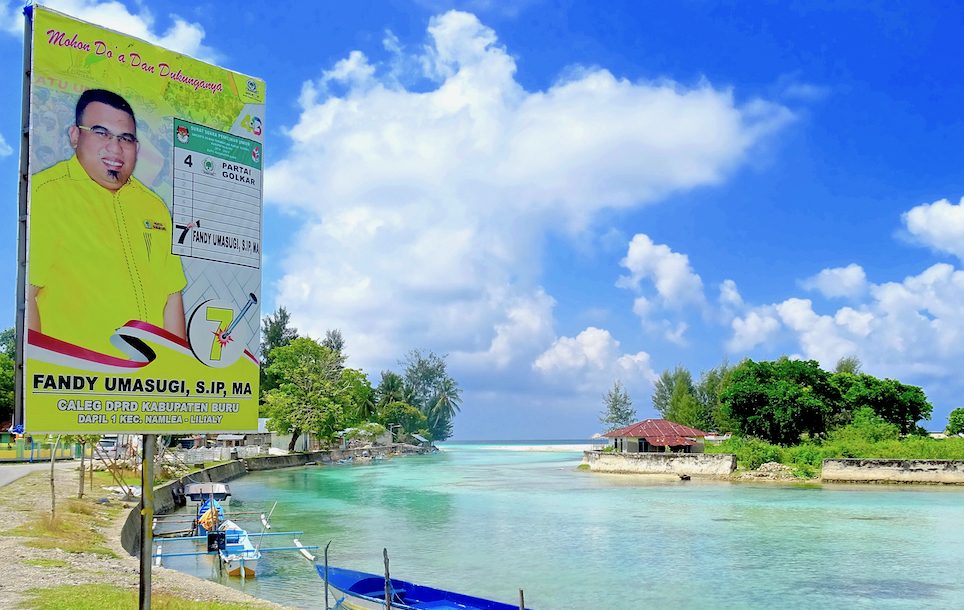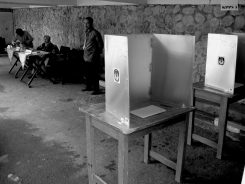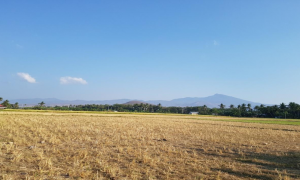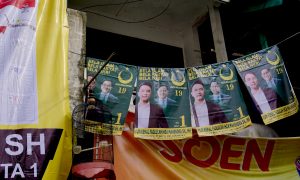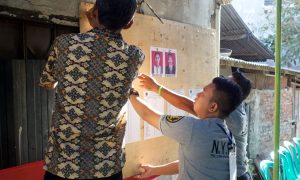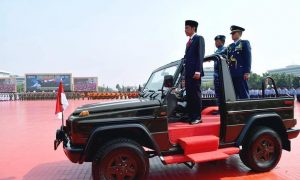Much of the journalistic and academic coverage of the 2019 Indonesian elections has concentrated on the national theatre of the presidential rematch between the incumbent, Jokowi Widodo (or “Jokowi”), and his long-time challenger, Prabowo Subianto. At this national stage, the main measures of the state of the contest have been the Jakarta-based debates, national polls and the social media wars managed out of the capital as well.
But for many Indonesians, far more important than these national dimensions of the presidential contest are the ways in which it impacts on the social, religious and political relations in their villages and townships. Similarly, the concentration on the national news cycle has distracted from other aspects of the elections that are of equal or even higher significance for a lot of citizens, especially those living in the periphery. Most crucial among them are the elections at the lowest legislative level, namely the ballots for the district parliament. That is the level at which many voters know candidates personally, and it is also the level at which most decisions affecting citizens’ everyday lives are made.
This article explores the grassroots repercussions of Indonesia’s national elections through an extensive account of the campaign in Maluku, an archipelagic province of 1.7 million inhabitants (among them 1.2 million voters) in the country’s east. Drawing from interviews with candidates and voters in Ambon, Tanimbar, Buru and Banda, I sketch out the presidential election in the province, analyse its relationship with the legislative ballots, and take a close look at the patterns of district-level elections as well as the issues dominating them. In observing the relationships between local communities and political actors, and between those local leaders and national state and party elites, I argue that the entrenched character of political competition at the local level is one of the key factors that would mitigate against attempts to re-establish the kind of centralised authoritarian system that existed during the New Order.
At the same time, however, Maluku exhibits many of the problems that afflict Indonesian democracy more broadly: these include the deep divisions among presidential electorates on the basis of identity, the hollowing out of political parties and the proliferation of dynasties at the local level, as well as pervasive clientelism. So while the formal institutions and procedures of Indonesia’s democracy are well-entrenched in 2019, it is palpable at the grassroots how the quality of that democracy continues to erode.
Presidential and identity politics
In a recent report on the elections in Maluku, The Economist made the surprising observation that “the province is refreshingly free of identity politics”. This is not only an odd conclusion; in fact, the opposite is true. Arguably, in no other province in Indonesia do voters so consistently support presidential candidates based on their religious identity. In 2014, Muslim majority areas voted overwhelmingly for Prabowo, while majority Christian territories supported Jokowi by large margins.
While Jokowi won Maluku in 2014 narrowly with 50.5% against Prabowo’s 49.5%, this seemingly tight contest masked the fact that each candidate won large victories in their respective strongholds. In the Christian majority districts (or kabupaten) of Southeastern and Southwestern Maluku, Jokowi gained more than 65%, and in Tanimbar and Aru even more than 70%. Prabowo, on the other hand, won big victories in the Muslim majority districts of Buru, Central Maluku, East and West Seram as well as Tual City.
In more religiously-balanced districts, the sub-district and village data showed a comparable trend. In Ambon City, where Christians form a majority but where about 40% are Muslim, Christian villages went strongly for Jokowi, while Muslim villages supported Prabowo. In Batu Merah, for example, the main Muslim quarters at the outskirts of Ambon and one of the main battlegrounds of the religious violence in the late 1990s, Prabowo gained more than 80% of the votes in 5 of the 6 local villages, while the nearby Christian village of Batu Meja was won by Jokowi with 85% support.
Recent visits to Batu Merah and Batu Meja suggest that not much has changed since 2014. In Batu Merah, Prabowo images and posters are widespread, and pictures of candidates from Islamic parties decorate the houses of residents. Many Batu Merah voters interviewed for this article expressed the view that the Jokowi government has failed to bring them prosperity, and they also tend to trust false rumours about Jokowi harbouring plans for abolishing Islamic education and even the call to prayer. Given how strongly Batu Merah opted for Prabowo in 2014, however, it is doubtful that these new rumours made any difference in determining local voter behaviour—they simply consolidated already existing positions.
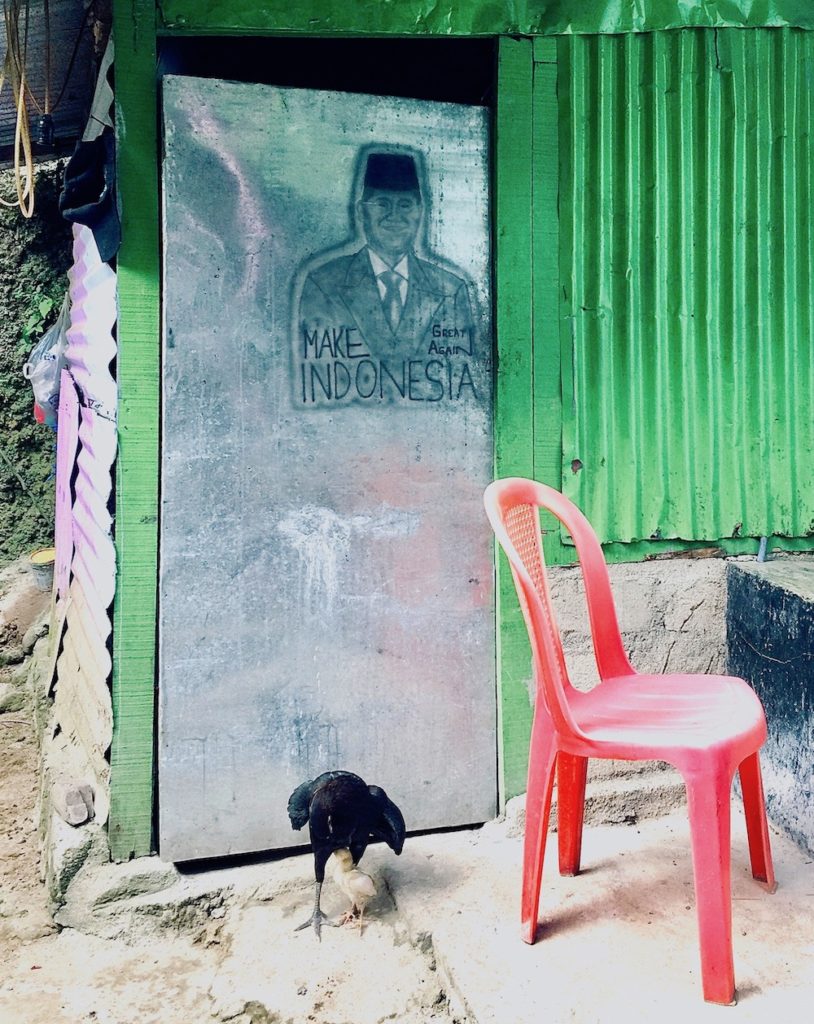
Prabowo image on a toilet in Batu Merah, Ambon (Photo: author)
In Batu Meja, similarly, voters seem to have maintained their strong loyalty to Jokowi. The village is clad mostly in red flags of Jokowi’s Indonesian Democratic Party of Struggle (PDI-P), and images of the president are proudly displayed. Christian residents expressed their fear that a Prabowo victory would be equivalent to a victory for Hizbut Thahrir Indonesia—the Islamist group banned by Jokowi in 2017. In addition, they are convinced that while their lives have not fundamentally changed since 2014, Jokowi is doing everything he can to make them better in the next term. As in the case of Batu Merah’s Prabowo voters, it appears that post-2014 events only served to confirm deeply anchored convictions among Batu Meja’s Jokowi loyalists.
This remarkable compartmentalisation of the Prabowo and Jokowi electorates in territorially fixed units is partly the result of population movements during and after the religious conflict in Maluku between 1999 and about 2003. Prior to the carnage, many areas were religiously mixed. Afterwards, however, segregation became much more common, with Christians fleeing majority Muslim areas, and vice versa. While stability has since returned, most territories maintained segregation as a conflict prevention strategy.
In the Banda archipelago in Central Maluku district, for instance, the sizable Christian minority left during the conflict and re-settled in the village of Suli on Ambon. As a result, Banda became religiously and politically much less diverse. 70% of Banda’s now strongly majority Muslim population voted for Prabowo in 2014—while Suli, the enclave of Christian Bandanese on Ambon, recorded a result of 75% for Jokowi. Visits to these two locations indicate, again, that the diametrically opposed voting patterns in the two communities have hardened rather than softened. In Banda, even politicians from parties aligned with Jokowi express support for Prabowo, while Christian voters in Suli echo the concerns of Christians elsewhere in Maluku over Prabowo’s possible facilitation of radical Islamic groups.
Official campaigners in these religiously homogenous areas know how to deliver their message without having to resort to openly primordial attacks on the opponent. Jeffry Waworuntu, for instance, a Christian candidate for the national parliament from PDI-P, campaigned in Batu Meja on a Sunday afternoon in late March. He used pointedly Christian vocabulary, asking the assembled residents to cite a prayer when voting for Jokowi—and for him. Jokowi, he asserted, was good for this Christian audience not only because he was building infrastructure and designed pro-poor policies—he was protecting the pluralist constitution of the state and thus, by implication, them.
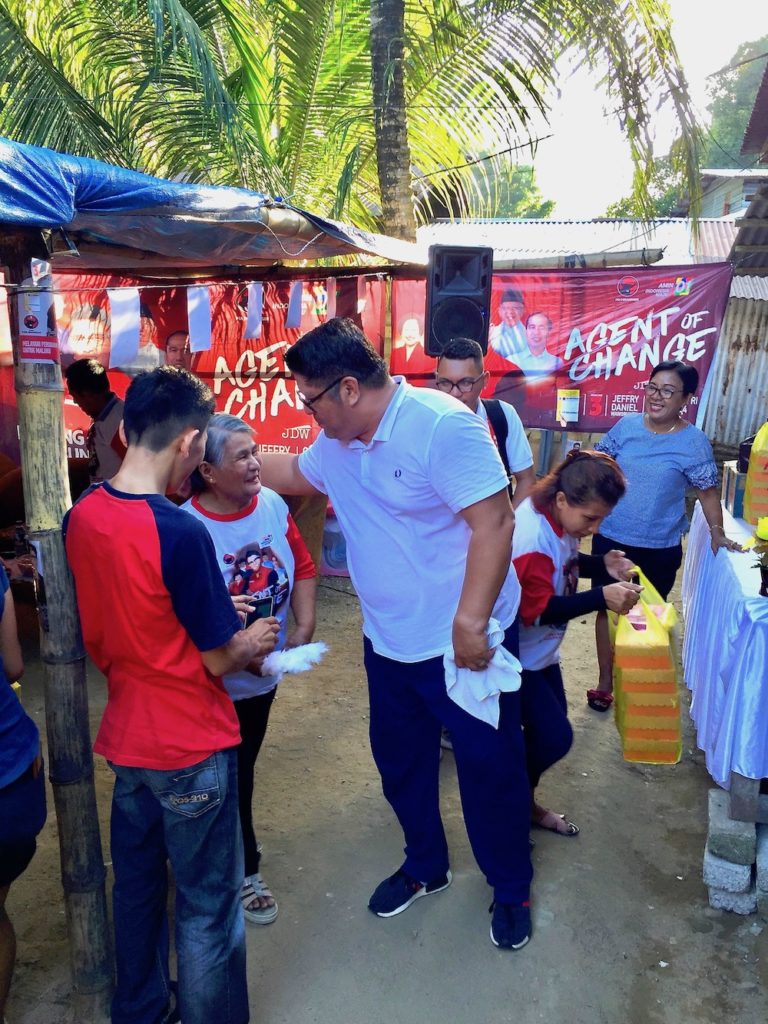
PDI-P’s national candidate Jeffry Waworuntu in Batu Meja, Ambon (Photo: author)
In the same vein, Batu Merah campaigners use Arabic terms to describe the qualities a president—and a candidate for political office in general—should have. Mixed with the rumours spread through social media and through mosque networks (i.e. that Jokowi is hostile to the Muslim community and wants to pass policies detrimental to its interests), these normative appeals to Islamic morality are designed to portray Jokowi as unelectable for pious Muslims. In much of the Malukan Muslim community, then, Jokowi’s attempts to obtain a more Islamic image—most prominently symbolised by the appointment of Ma’ruf Amin as his running mate—have been ineffective.
But while some local candidates and other figures have campaigned for Jokowi and Prabowo, the overall presidential campaign apparatus has been weak on both sides. The official campaign teams are poorly institutionalised, and operational posts are often empty or taken over by street sellers to market their goods. The Jokowi camp has tried to compensate for this weakness by mobilising local government heads for their candidate. Both the outgoing and incoming governors of Maluku, Said Assagaff and Murad Ismail, were integrated into the campaign infrastructure, and they obtained pledges of support from 9 of the 11 district heads of the province.
However, a number of the district heads have not followed through with their pledges. The district head (or bupati) of Buru, Ramly Umasugi, for instance, is the district chair of the Golkar party, which also nominated Jokowi. But as Prabowo won Buru in 2014 with a big margin, Umasugi gave no instructions to promote Jokowi in the party’s campaign events. Even his daughter, Gadis Umasugi, refrained from calling on voters to support Jokowi during her own campaign event for a seat in the provincial parliament, which the author attended. Asked what Gadis would have done had the audience asked for a presidential voting recommendation, one of her campaign helpers said that if forced to, she would have expressed support for Prabowo.
Prabowo, on the other hand, lacks the political machine support he enjoyed in 2014. Not only is he supported by fewer parties, he also has less money and weaker support from business and other professional groups that have taken a distance because they are dependent on relations with government. This is apparent across the country, but is particularly consequential in Maluku, where such support can often substitute for a thin campaign infrastructure in efforts to reach out to voters in remote parts of the province.
With these constraints, both presidential campaigns intended to leave much of the hard groundwork of voter mobilisation to the legislative candidates of their nominating parties. And indeed, the discussion among observers and practitioners in the lead-up to the campaign suggested that candidates would be keen to link themselves up with the two presidential nominees. Hoping for a coattail effect, so the theory went, legislative candidates in Indonesia’s first-ever concurrent presidential and parliamentary election would try to draw from the glamour of their party’s nominated presidential candidate to boost their own local campaigns. But the picture in Maluku—based on several weeks of observing the campaign—turned out to be substantially different.
Presidents and local candidates
The only candidates who with some form of consistency included the images of their party’s presidential candidates on their own campaign posters have been those of PDI-P and Prabowo’s Gerindra. While it had been expected that the two parties whose own cadres ran for president would benefit most from the coattail effect and hence would see particularly intense efforts by its legislative candidates to associate with them, Maluku candidates of PDI-P and Gerindra have not always voluntarily done so.
In many cases, the candidates’ promotion of presidential nominees has not been the former’s initiative, but based on orders by the party. PDI-P, for instance, issued a clear and publicly announced instruction to all candidates to feature an image of Jokowi and Ma’ruf Amin, as well as one of party chair Megawati Sukarnoputri and her father, founding president Sukarno. Violators of this regulation were threatened with sanctions.
But despite this clear order, many Malukan PDI-P candidates ignored it and only put their own images on their campaign material. In some cases, they preferred to include pictures of famous relatives, both dead and alive. National candidate Safitri Malik Soulisa, for instance, posed in front of her husband, the district head of South Buru. Provincial nominee Natashya Alexandra Litaay, for her part, showed her dead father—former PDI-P secretary-general and respected Malukan figure Alex Litaay—on her posters. Both candidates printed a limited number of posters that included Jokowi’s image as well, but that was largely done to formally meet party requirements.
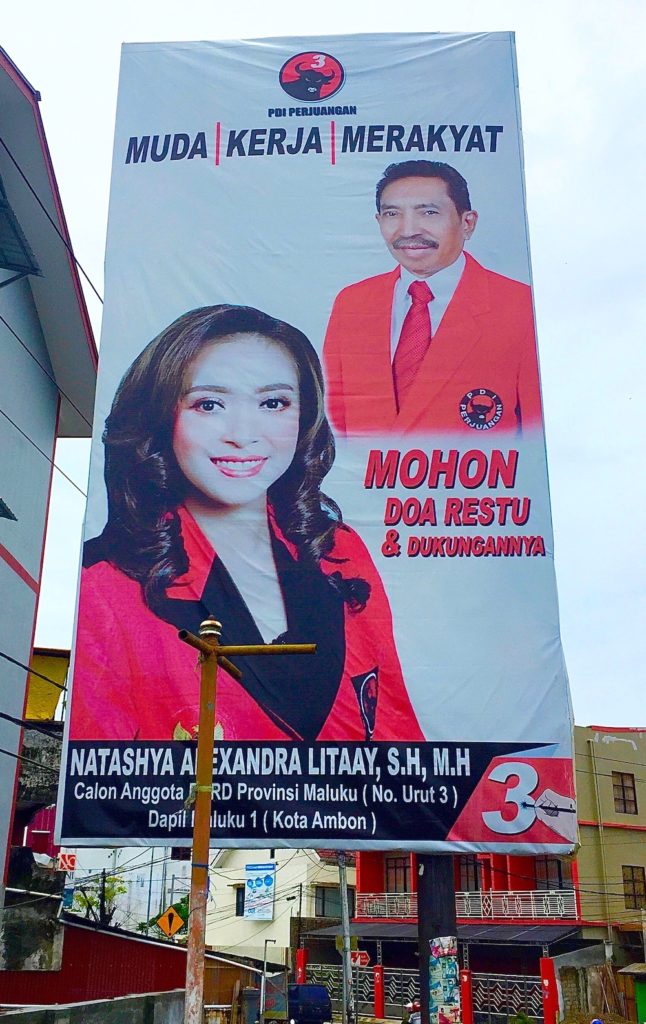
PDI-P candidate Natashya Litaay posing with her dead father instead of the president’s image (Photo: author)
Other PDI-P candidates have not gone to such lengths. Especially district-level candidates with limited budgets could not afford to print different sets of posters, and thus only produced material with their own image on them. This includes some areas in which Jokowi is particularly strong, such as on Tanimbar, where the president gained 76% in 2014.
The patterns in the Prabowo campaign are similar. Gerindra candidates were strongly urged by their central party to feature a picture of Prabowo and his running mate, Sandiaga Uno, on their campaign posters. Many obliged, and some even added a picture of Rizieq Shihab, the exiled leader of the Islamist demonstrations against the government in 2016 and 2017. But others chose not to include Prabowo in their material, and focus exclusively on promoting their own candidacy. This included areas in which Prabowo has been exceptionally dominant, such as Buru or Banda.
While the willingness of candidates from the main nominating parties to use the image of their patrons is sketchy, it is close to zero among Malukan nominees from other presidential coalition parties. Golkar, whose central board was the first to re-nominate Jokowi as president, and which had spent much time and effort on presenting Jokowi as part of the Golkar family, had required its candidates to feature his picture on their campaign materials. But hardly any Golkar candidate did. Nasdem, whose national slogan is “Jokowi is my president, Nasdem is my party”, saw a comparable outcome. A handful of nominees featured an image of Jokowi—typically together with party chairman Surya Paloh—but the vast majority did not.
What explains this contrast between predictions of candidates rushing to benefit from a supposed coattail effect and the reality on the ground in Maluku? First of all, it is important to understand the priorities of candidates. Nominees for legislative positions view the presidential contest as significant, but it is nowhere as important to them as their own candidacy. It is their personal campaign for which candidates often sell possessions or take bank loans, and upon which their family’s financial future depends.
It follows from this, second, that nominees design their campaign strategy based on maximising their own personal vote, not that of the president or party. Under Indonesia’s fully open party list system, a candidate gains a seat if a) the combined vote of all party nominees, plus the party-only ballots, wins that party one or more seats, and b) the nominee is among the party’s top achievers in the personal vote count, with seats distributed based on best results until the party’s seat quota is exhausted. Especially at the district and provincial levels, the margin of victory for the intra-party competition between candidates is often very small, with a handful of votes deciding success or failure.
Accordingly, many candidates have concluded that, third, featuring the images of presidential candidates on their campaign posters carries more risks than benefits. This is because identifying with a specific presidential candidate is unlikely to attract many additional votes, but risks alienating those who deeply dislike that nominee. In a society so strongly polarised between Jokowi and Prabowo voters as Maluku’s, associating with a presidential nominee disliked even by a small segment of the electorate could cost the local nominee crucial votes and, thus, the seat.
This is even true in areas in which one presidential candidate heavily dominates. As mentioned above, Jokowi received three quarters of the votes in Tanimbar in 2014, making it tempting to assume that associating with him might boost a candidate’s individual vote. But while some nominees—especially those from PDI-P—do exactly that, the vast majority of candidates from other nominating parties don’t. The reason is the fear of losing the opportunity to compete for votes among the roughly one quarter of the electorate that tends to affiliate with Prabowo.
One Golkar candidate on Banda illustrated this dilemma in his particular case. Banda is heavily pro-Prabowo, so it was out of the question for him to affiliate with Jokowi, as instructed by his central board. But openly identifying with Prabowo was problematic too, given that it would bring him in conflict with his party and close the door to the 30% of the local electorate that voted for Jokowi in 2014. He based his personal campaign on his role as a supervisor for village funds in his home village, which includes a small but not insignificant amount of Jokowi supporters. Given this image building as a community activist, maintaining nominal neutrality in the presidential race made the entire electorate available for him, instead of just the supporters of a specific presidential candidate.
These dynamics are partly due to the way electoral boundaries are drawn. In many areas, electoral districts (or dapil) include both majority Christian and Muslim villages, and therefore both Jokowi and Prabowo strongholds. The second district for the city parliament of Ambon, for instance, includes the strongly pro-Prabowo communities of Batu Merah and Pandan Kasturi as well as the pro-Jokowi villages of Galala and Hative Kecil. Hence, while openly campaigning for a presidential candidate might win votes in half of the electorate (and some candidates choose that option), it closes off the other half from contestation. As a result, most candidates outside of PDI-P and Gerindra, and even many nominees from these parties, have decided to adopt a personalised campaign without references to the presidential race.
Hence, while the coattail effect will have to be thoroughly analysed based on the post-election data, it appears to be much more complex in practice than initially assumed. Especially at the district level, it looks likely that—at least in Maluku—the effect will be limited. Candidates have prioritised their personalised votes over achieving down-ballot consistency between presidential as well as national, provincial and district level elections, and voters have shown little commitment to such coherence either. Indeed, there are many indications that the district-level elections will produce a highly fragmented political party landscape in the regions, with voters picking individuals irrespective of their party affiliation or presidential preferences.
Ground game in the districts
Most Malukan voters interviewed for this article had reasonably firm views on two out of the five elections taking place concurrently in Indonesia on 17 April: they knew how to vote on the presidential candidates, who they were familiar with from television and—as indicated above—allowed them to position themselves within the identity cleavages of Malukan society and Indonesia’s broader ideological landscape; and they knew, and were often very passionate about voting for, local candidates at the district level. By contrast, few voters had heard about, or cared much for, candidates for the province and national parliaments, as well as the senate-style DPD.
There are many reasons why many voters view the significance of the district level elections as being at par with, or even as more important than, the presidential ballot. First, the majority of voters have some kind of personal connection to at least one of the candidates. Some of the nominees are family members, while others are employers, community workers, religious figures or simply originate from the island or village of the voter. Particularly in remote, small-population areas such as Banda and Tanimbar, it is very common to encounter voters whose brothers, fathers, uncles or aunts are running for the district parliament. A group of female voters interviewed in Tanimbar even stated that several of their family members were in the race, producing the need to “distribute the votes evenly in the family”.
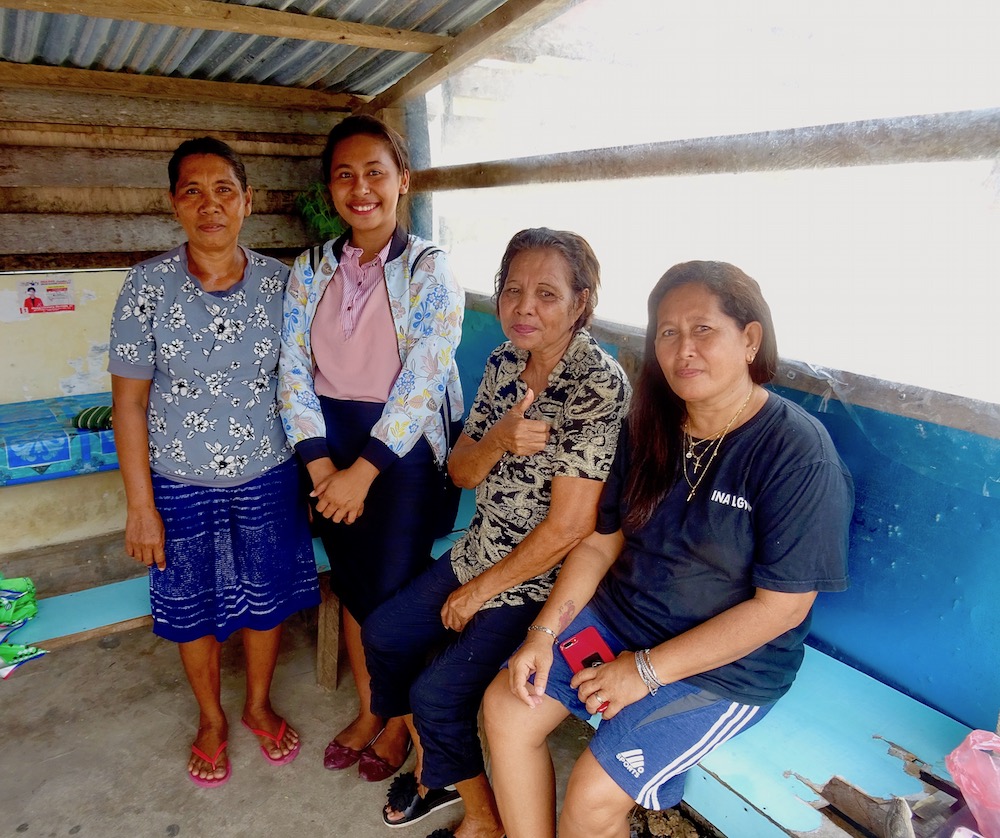
Female voters in Saumlaki, Tanimbar (Photo: author)
Second, the district level is where many of the decisions are made that affect the everyday lives of Malukans. Most voters are concerned with the low quality of their village and town roads; the lack of sufficient boat and air travel linkages; the poor phone and internet connectivity; the unavailability of water and sanitation facilities; and the bad management of local markets. These are all issues for which the presidential vote is unlikely to provide any remedies, and while there is disillusionment with local politicians as well, many residents believe that voting in one of their relatives or otherwise acquainted society leaders will bring change.
Third, the district level is where a vast amount of the government budget is concentrated and spent. Roughly half of Indonesia’s total public sector spending (outside of credit service, subsidies and pensions) is now taking place at the subnational level, and about 85% of intergovernmental transfers go to the districts. As a result, district parliaments have become an important place of brokerage for projects and their allocation to particular companies and locations. Unsurprisingly, then, this budgetary clout of district-level governance has been attractive to candidates and voters alike.
The real ground game of the elections in Maluku, then, is at the district level. With presidential campaign teams weak and provincial as well as national candidates covering electoral constituencies that are much too large for them to have a consistent presence on the ground, it is the candidates for district parliaments that are most active and visible. They are the ones who run door-to-door campaigns; often have promoted themselves in communities for years before the election period began; and have the most concrete offers to make in terms of promised programs for voters.
There are, broadly speaking, two types of candidates at the district level. The first is the locally grounded nominee with strong family and/or community roots. Such candidates often hope to maximise their vote in their immediate surroundings, i.e. the villages or islands closest to their place of residence or activity. They mostly forego campaigning in other parts of the electoral district in order to collect their necessary vote share from their personal networks. Most candidates have made concrete calculations of the number of votes they need to obtain in order to gain a seat, and stay in constant contact with the voters in their networks to prevent defections.
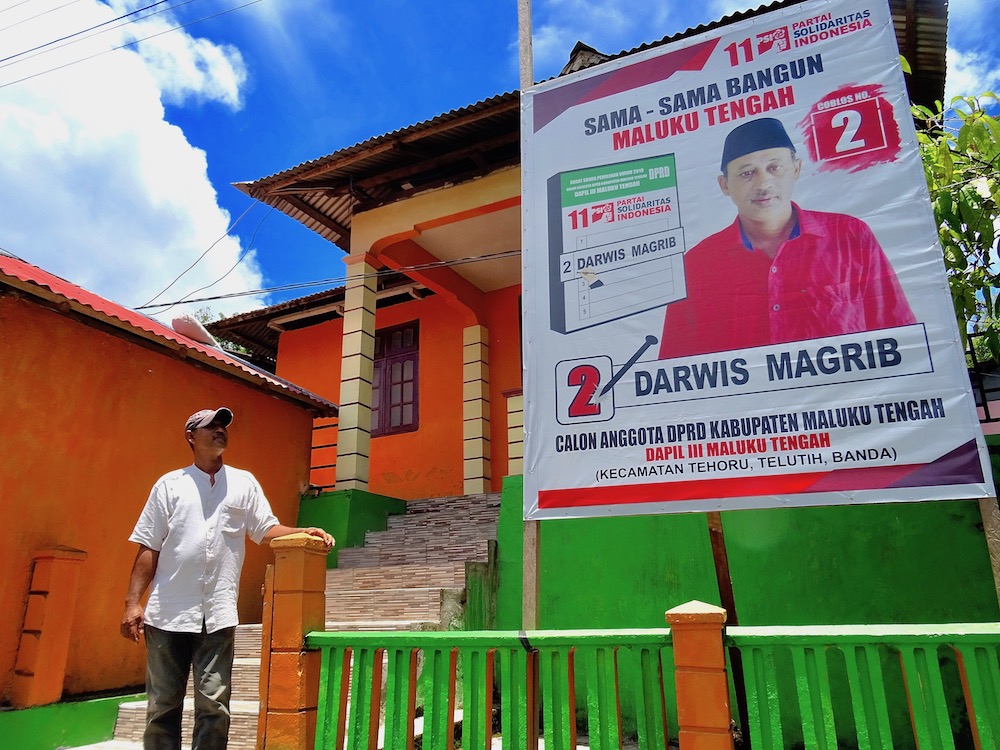
Community-based PSI candidate in Lonthoir, Banda (Photo: author)
The second type comprises of nominees who lack social and familial connections to grassroots voters but possess the necessary cash to campaign in the entirety of the electoral district—and to buy votes. They are often entrepreneurs, small-town bureaucrats or relatives of district or province-level officials. Mobilising their monetary resources and political connections, they spread their posters into all corners of the electoral district, with their content often adjusted to local circumstances. They hire brokers who seek commitments from voters and, in the last days of the campaign, often hand out cash to voters.
An archetypical example of this latter kind of candidate is the chairman of the Tanimbar branch of Tommy Suharto’s Partai Berkarya. As the unpopular son of Indonesia’s long-time autocrat Suharto, Tommy systematically recruited local businesspeople to establish the party’s regional network. In exchange, these affluent figures frequently put themselves at the top of the party’s local candidates list. In Tanimbar, this role fell to a young Chinese contractor whose family owns all major hotels in the district capital of Saumlaki. Having reportedly been cut out by the Tanimbar district head from government contracts, the contractor decided to run for the district parliament to challenge the hostile district chief. His high-profile posters are now placed all over the district, and are rivalled in quality and distribution only by Rano Fatlalon’s, the son of the targeted district head.
It appears straightforward to conclude that this second type of candidate has a significant advantage over the first, as much of the empirical evidence in Indonesian election research (especially on the Outer Islands) would suggest. And indeed, Maluku’s geographic and political conditions appear to favour cashed up elite nominees over those anchored in their communities. Candidates all over Indonesia find it hard to cover the entirety of their constituencies, but the boundaries of many Malukan electoral districts makes this particularly difficult.
The Banda archipelago, for example, is part of the third electoral district of the Central Malukan parliament. This constituency also includes the sub-districts of Tehoru and Telutih—a one-day boat ride away from Banda. Only candidates with the necessary resources can afford to campaign in all three sub-districts of the constituency. Once again, the chairman of the local Partai Berkarya branch—this time Banda’s Faruk Baadilla—was one of the few able to do so.
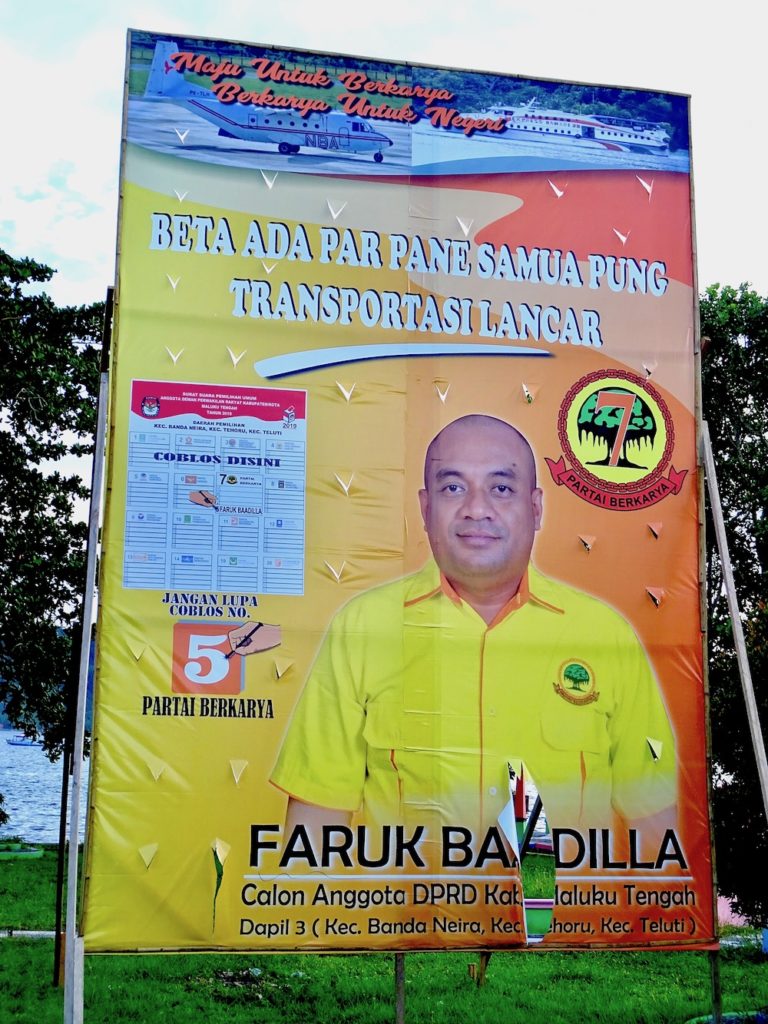
Banda’s Partai Berkarya chairman and candidate Faruk Baadilla (Photo: author)
Yet that doesn’t mean that community candidates are without a chance. The voter interviews conducted for this article indicate a high level of militancy among voters associated with candidates through familial, local, religious and other social relationships. And while Burhanuddin Muhtadi’s ground-breaking surveys have shown that about a third of Indonesian voters accept money handed out by candidates, this leaves two thirds who don’t—plus a significant amount of others who take the money but vote for somebody else than the benefactor. Thus, at least a few of the locally anchored nominees are certain to make it into their district parliament.
But whether community candidates or elite nominees prevail, the trend of personalisation of legislative elections appears to have strengthened further during the 2019 campaign. As the electoral system transformed from a fully closed to a fully open party list system between 1999 and 2009, this personalisation proceeded gradually, but it now seems to have reached new heights. As the chairman of Golkar’s Banda branch observed, the local parliamentary elections are now no different from the five-yearly executive polls for local government heads (or pilkada). In both cases, local parties only play the role of providing an electoral vehicle to the candidates, who then run self-funded campaigns focused on their personal program and achievements rather than those of the party.
The personalisation of campaigns at the district level has partly been a consequence of a specific twist in the electoral system. Unlike at the national level, there is no parliamentary threshold for provincial and district-level parliaments. The national parliament tried to introduce such a local threshold for local legislatures in 2012, but the Constitutional Court subsequently scrapped that regulation. This means that local candidates can obtain a seat by personally reaching a seat quota, regardless of how the party performs in other electoral areas. This reduces the incentive to campaign for the party as a whole and provides further encouragement to individualise the quest for community support.
New parties have been particularly suitable political vehicles for nominees who seek to personalise their campaign at the local level. Widely ridiculed for having no chance to enter national parliament because of the 4% threshold, the newcomers have, in fact, become attractive options for non-party figures who wish to avoid competing with cadres of established parties for a slot on their candidate lists. Many cashed up nominees thus chose new parties over older ones, which would have imposed at least some extent of programmatic or ideological catalogue on them. A significant number of them will make it into the 11 Malukan district and city parliaments, potentially producing electoral results vastly different from national-level outcomes—even in the same electoral constituency.
Expansion of dynasties
The patterns of resource concentration and personalisation of campaigns at the district level have also intensified an already strong, pre-existing trend: namely, that of dynasty building by district heads. There has been much literature on this phenomenon, highlighting both commonalities and differences between political dynasties in the Philippines and Indonesia. Overall, dynasty building is still significantly stronger in the Philippines, but Indonesia’s local rulers have done much recently to catch up.
In Maluku, at least 8 out of 11 district heads and mayors (or walikota) have pushed the candidacies of their family members in the upcoming elections. The most aggressive in this dynastic quest have been the district heads of Buru, Central Maluku and Tanimbar. In Tanimbar, the district head Petrus Fatlolon supported the legislative nominations of his son and his younger sibling. In addition, the former district head, Bitzael Temar, is also running for parliament, accompanied by the candidacies of his wife and son.
The district head of Buru has launched an even more ambitious dynastic project. Ramly Umasugi supports the candidacies of no fewer than six family members—a daughter, several nephews and a son-in-law. At campaign events, Umasugi family members have not tried to downplay their relationship with Ramly in fear of nepotism accusations. Quite on the contrary, they have highlighted their access to the district head as their biggest asset. During a community campaign event in Namlea, Ramly’s daughter Gadis drew the loudest applause when she introduced herself as the district head’s daughter and defined her biggest policy goal as helping her father to coordinate his executive policies with the legislature.
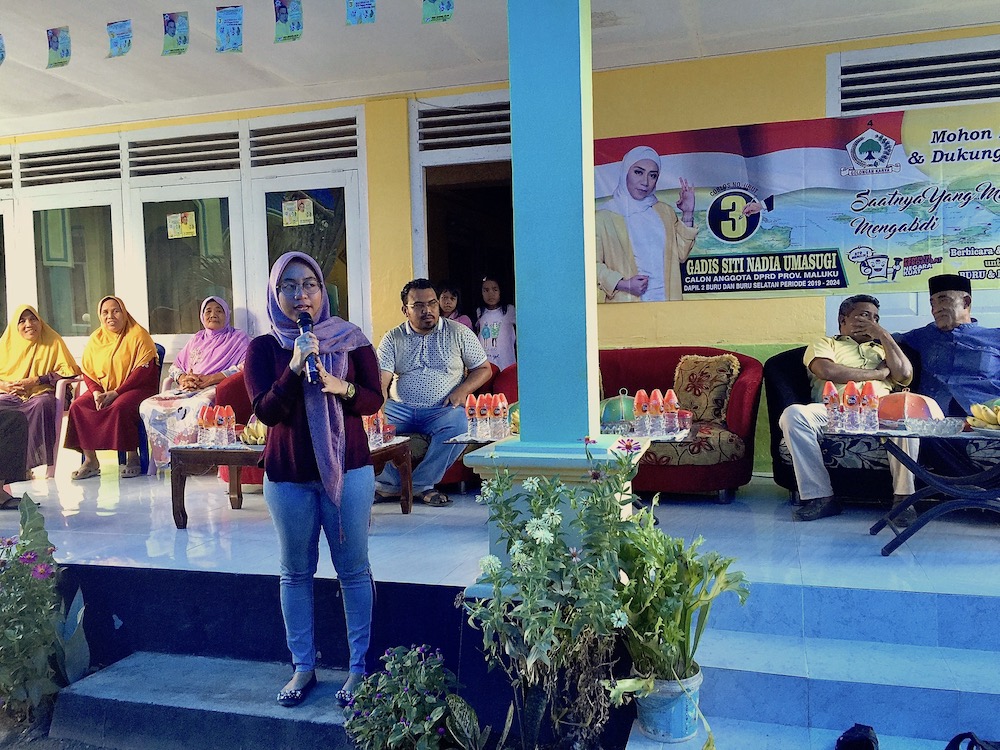
Gadis Umasugi campaigning in Namlea, Buru (Photo: author)
Most voters in Buru have been unfazed about continued corruption allegations directed against Ramly Umasugi. A group of female Namlea street sellers interviewed for this article expressed the view that it is acceptable for a ruling family to “take some money”. The important thing, they asserted, was that the poor were also assisted with payments, food and small grants. As long as those services were delivered, a certain level of corruption was acceptable to them. The women were also highly supportive of Gadis’ candidacy, saying that keeping political offices within the family would guarantee the continuation of the services already provided.
Gadis openly tapped into this sentiment during her Namlea campaign event. Appearing together with her cousin and another relative (both legislative candidates as well), she promised the crowd that if elected, she would be as “generous” with requests for financial assistance as her father is. In this regard, she pledged, “the apple does not fall far from the tree”. Her offer of continued patronage delivery was greeted, once again, with much approval from the mostly female audience.
The Tuasikal family in Central Maluku has spread its political tentacles in a similar fashion. Abdullah Tuasikal, who ran the district between 2002 and 2012, handed over the position to his brother Abua and is now running for the national parliament. Abdullah’s wife and three of Abua’s nephews are also running for legislative seats. Just as the Umasugi family in Buru, the Tuasikals have faced frequent corruption allegations, but as in Buru too, the family and voters have shown few signs of concern.
Many Maluku dynasties have become so strong that they were able to turn their associated political parties into exchangeable vehicles of convenience and strategic adaptation. Abdullah Tuasikal was a Golkar politician in the past, but is now running for Nasdem—with some speculating that he made the shift in order to reduce the risk of criminal investigations by the Attorney General, a Nasdem politician.
Similar rumours surrounded Fatlolon’s move from Partai Demokrat to Nasdem in 2018. Fatlolon explained his manoeuvre by his wish to support Jokowi’s re-election, which his previous party would not have allowed him to do. Whatever the reason for these shifts, they are a sign of the increasingly utilitarian usage of parties by local dynasties. The Tuasikals and Umasugis have even spread family members across the party landscape to cover all bases.
National and democratic repercussions
While the elections in Maluku reflect the provinces’ specific geographical, social and political conditions, they in many ways illustrate broader patterns at the national level. For each of this article’s key findings (on the deep divisions among presidential electorates; on the missing link between presidential and local campaigns; on the importance and personalisation of district-level ballots; and the proliferation of dynasties), there are equivalent developments in other regions or in the national campaign.
To begin with, the continuously high polarisation between the Jokowi and Prabowo electorates is remarkable in Maluku, but is not dissimilar to the national picture as a whole. For all of Jokowi’s incumbency advantage, the high-profile infrastructure projects, economic stability, pro-poor policies and voter satisfaction ratings of 70% or more, the president has struggled to move the electoral needle significantly above his 2014 result of 53%. By all accounts, Jokowi himself is surprised and frustrated that his five years of carefully crafted government policies and messaging have not put him in the same hegemonic position that former president Susilo Bambang Yudhoyono enjoyed in 2009.
The reason for this is that the presidential race reflects a deeply ideological split between non-Muslim minorities and pluralist Muslims on the one side and more conservative Muslims on the other. Polls have repeatedly shown that there is a strong correlation between being a non-Muslim or pluralist Muslim and voting for Jokowi, and being a conservative Muslim and voting for Prabowo. Polls have also demonstrated that minority voters and pluralist Muslims hold a slight majority over the conservative Muslims—despite the hype around the Islamist mass demonstrations of 2016 and 2017. While Yudhoyono was able to appeal to both religiously pluralist and conservative Muslim constituencies, Jokowi and Prabowo recruit their supporters predominantly from their core groups.
This does not mean that there has not been some movement in those constituencies. Jokowi has tried to portray himself as more Islamic than he did in 2014, and the selection of Ma’ruf Amin was a transparent attempt to pull conservative Muslims to his side. He has also sought to use his incumbency powers (through the mobilisation of state officials as well as the police and military) to entice previous Prabowo voters to switch into his camp. Should Jokowi record a better result than in 2014, both in Maluku and nationally, it will have been the result of these two operations, into which Jokowi invested massively.
But most pollsters believe that if Jokowi gains, those increases will be moderate. A recent Kompas projection put the likely Jokowi end result at around 56%, and other survey institutes expect a similar outcome. This would mean a rather mediocre swing of 3% towards the incumbent, highlighting how most voters stuck to their longer-term positions.
Second, the disconnect between the presidential and legislative races has not only been observed in Maluku. In Riau, the local PDI-P branch complained that except for its own parliamentary nominees, most candidates from parties supporting Jokowi had not put up his image or campaigned for him in any other way. In Maluku, at least, that also applied to many PDI-P candidates. As explained in this article, many local candidates have concluded that identifying with a presidential nominee risks losing potential voters who strongly oppose that nominee. Given the strong polarisation of the presidential race discussed above, and the small amount of votes that typically decides the allocation of seats in local legislative races, this approach appears sensible.
Nevertheless, some form of coattail effect is likely to occur. At the national level, where voters are least familiar with the candidates, the probability of synchronisation between presidential and legislative vote is highest. But at the lower levels, the effect is likely to be much smaller, and it is reasonable to expect a large gap between national, provincial and district-level party results. Even at the national level, however, the impact of vote buying, personalised campaigns and local conditions make it improbable that the coattail effect will massively advantage PDI-P or Gerindra, the main “presidential” parties. As in 2014, some pollsters have predicted a result of between 30% and 40% percent for PDI-P; but as in 2014, it is likely going to be lower.
Third, the “pilkada-isation” of the district-level legislative elections has major implications nationwide. While this increasing personalisation and dissociation from parties is stronger in the Outer Islands than on Java, it further undermines party institutionalisation at the grassroots. Both voters and candidates have pushed this trend. Voters increasingly prioritise family connections, local origin or some form of other personal relation with the candidate over the nominee’s party affiliation. At the same time, the existing electoral system forces candidates to maximise their own vote over that of their fellow party nominees, encouraging strong personalisation of the campaign.
The lessons from the weakness of the presidential ground game, the potentially limited coattail effect and the increasing concentration of personalised campaigns at the district level are obvious. If parties want to establish better links between presidential and legislative campaigns, as well as between the various levels of their parliamentary candidacies, it is not enough to rely on making all these elections simultaneous. There had been a widespread expectation within national party leaderships that the switch to holding concurrent presidential and parliamentary elections would automatically create synchronisation effects. But achieving this synchronisation effect requires, rather, better integration of district-level party branches into the national party organisation, and reforming the current fully open party list system, which breeds individualised legislative campaigns.
One product of the status quo described above has been the hijacking of party district branches and candidacies by local dynasties. This article has highlighted some particularly blatant cases in Maluku, but the trend is visible across Indonesia. In Kediri, the local PDI-P chairman and former district head—whose wife succeeded him in that post—re-nominated his brother for the local parliament against the protests of some local party cadres. The central party board did not intervene, leaving local party leaders with almost complete freedom to advance the interests of their family members.
The outlook: dissent, defects and deconsolidation
What, then, does a look at Indonesia’s election campaign at the periphery tell us about the state of the country’s democracy? First, the good news: while Jokowi has tried to exploit his incumbency advantage in more aggressive ways than his post-1998 predecessors, his attempts to mobilise local officials for his re-election campaign have had only limited success. Local leaders may have pledged support but were often reluctant to deliver on those promises. Partly this has been due to their knowledge that lobbying electorates in traditional Prabowo strongholds to vote for Jokowi will hurt their own electoral prospects—and those of their family members.
But another part of the explanation is that it has been close to impossible to systematically herd voters and candidates into supporting the incumbent in a society that has become used to dissent and differentiation. This anarchy of interests at the grassroots rebels against any attempt to re-establish authoritarian models of political centralisation along the lines of Suharto’s New Order regime. After twenty years of democratic competition, voters and candidates alike have gotten used to pursuing interests that are incompatible with the limited political participation opportunities under the three-party New Order. Significantly reducing the current political opportunities for candidates and voters would thus trigger much resistance.
But as someone who toured Indonesia during the 1999 elections (and all other subsequent national elections as well), I find it hard not to note signs of increasingly severe democratic defects. In 1999, vote buying was very limited, as campaigns were party rather than candidate based. Today, Indonesia is the country with the third-highest incidence of vote buying in the world. This is based on 2014 data, but there are no indications that vote buying will be less intense this time. Unless they have close family or other social ties to the candidate, many voters in Maluku stated that they are happy to receive money from candidates and vote accordingly. The recent arrest of a candidate in Java who had stuffed Rp8 billion (A$800,000) of corrupted money into 400,000 envelopes also indicates that vote buying will remain at least as intense as in 2014.
Twenty years of Indonesian democracy—how many more?
Two decades after Suharto’s fall, it’s hard to see a return to dictatorship—or to declare the democratic status quo safe.
To be sure, polarisation is not always unhealthy in democratic polities. Indeed, stark differences between candidates are important ingredients of democracy—if those differences are programmatic, strategic and political in nature. In Indonesia, however, the polarisation at the top—with trickle down effects at the grassroots—has taken on a pointedly primordial character, defining political preferences primarily in relation to the role of Islam in state affairs. This kind of polarisation erodes, rather than strengthens, democratic quality.
A similar narrowing of electoral space has taken place in the party landscape. In this case, however, the narrowing has not increased polarisation, but has offered political advantages to oligarchs and other patronage actors. In 1999, 48 political parties participated in the elections. Many of them proved unviable, but there were a number of labour-based and other segmental parties that offered a home to specific communities. Subsequently, however, the registration requirements for new parties were gradually increased—ultimately mandating that a party maintain an organisational presence in all provinces.
As a result, only wealthy political actors have been able to afford building a new party. In 2019, four new parties entered the race: Tommy Suharto’s Partai Berkarya; Partai Garuda, linked to the Suharto family too; Perindro, founded by media mogul Hary Tanoesoedibjo; and Partai Solidaritas Indonesia (PSI), a much-praised party of young activists—but made possible only by large donations from tycoons as well. Void of any programmatic orientation, Partai Berkarya, Partai Garuda and Perindro have become vehicles for ambitious local businesspeople and other predatory actors to pursue their interests. PSI, on the other hand, often struggled with its attempt to select high-quality candidates, thus failing to achieve the impact it aimed for.
This increasingly oligarchic party system has served the interests of local strongmen, who take over party branches in the regions and place their family members across the candidate lists. This is because oligarchic national party leaders need to sub-contract the establishment of local branches to other actors on the ground to reduce their investment risk. Consequently, statistics have shown a consistent increase in the number of entrepreneurs in parliament since 1999, pushing aside the kind of long-term party activists and community leaders that constituted the majority of candidates in the first post-Suharto election in that year.
Overall, then, Indonesian democracy remains functional and internally competitive, but its defects increasingly threaten its long-term prospects of moving beyond its current low-quality status. Indeed, there are significant signs, elaborated above, that elements of Indonesian democracy are regressing rather than consolidating further. Hence, while this year’s election campaign provides evidence for Indonesian democracy’s continued ability to avoid a return to full authoritarianism, it also supports the narrative of a slow process of democratic deconsolidation.
In this process, the foundations of democracy are still in place, but their democratic substance is gradually eroded. Given the type of politicians that the current electoral system produces, there is little hope that the new government and legislatures emerging from the 2019 polls will stop this erosion. Indeed, further democratic backsliding appears the far more likely scenario.
 Facebook
Facebook  Twitter
Twitter  Soundcloud
Soundcloud  Youtube
Youtube  Rss
Rss 